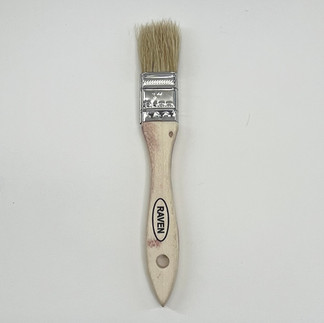Recipe 2 : Face Mold Making
- Koji Ohmura
- Sep 4
- 4 min read
Updated: Nov 2
The face mold will allow prosthetics to fit on your face perfectly. No more hassle with bad edges or ill-fitting prosthetics going over your eyes!

In last recipe, we learned how to make a life-casting mold. This recipe features how to make a plaster face mold from the life-casting mold.
Materials you need...
Vaseline
Face Mask
Water
Mixing Bowl
Gloves
Chip Brush
Plastic Bag
Hydrocal White (Optional)
Ultracal 30
Rasp
Sculpting Tools
Project Board
Body Double Fast
Mixing Cups
Tongue Depressor
Air Compressor & Air Hose (Optional)
Knife
Plaster Bandages
Burlap Roll
Chavant Sculptex (Kleen Clay)
Detail Torch
Wed Clay
Krylon Crystal Clear
Krylon Dulling Spray
Material links are here.
Lesson Video
Mold Prep
Let's use the life casting mold from the last recipe. Brush Vaseline on a plaster bandage shell. This will make the silicone fit well. Also, the plaster face mold comes out easily later.
Fill nose holes with Kleen Clay (Chavant Sculptex). Try not to change the shape too much.

Keep the nose shape when you fill the holes.
Plaster Mold
Pour a small amount of water in a bowl. (Paint Vaseline on the bottom of the bowl)
Sprinkle Ultracal 30 (or Hydrocal) into the water until the surface looks like a dried lake.

Dried lake surface Mix it with your hand. No chunks left in the mixture.
Brush a thin layer of plaster on the silicone.
Add more to make a good thickness.
Smooth out the surface.
Cover the mold with a plastic bag.
Do NOT throw away the plaster leftover in a sink. It will clog the pipe. Throw it away into a trash can.

Fill it to the top.
Demold
After 2 hours, remove the plastic bag. (The plastic bag makes the mold strong.)
Remove the plaster mold from the life casting mold.
Clean the sharp edges and imperfections with sculpting tools & a rasp.
If you see some facial hair, burn it with a torch.
This is called a "Positive Mold" and is ready for sculpting. The next step below is optional. If you have extra time and budget, I recommend you do this in order to make a stronger mold. It will also create more possibilities!

Positive mold after clean ups.
Flared Out Mold (Optional)
Place the positive mold on a project mold.
Cut Wed Clay in 1-inch thickness and put it under the positive mold.
Trim the side at an angle and smooth out. (Look from the sides and top. Make it look like a flared-out mountain.)
Fill all gaps and no undercuts.
2 layers of Crystal Clear. Dry each layer.
1 layer of Dulling Spray.

Fill all undercuts.
Silicone Master Mold
Prepare a 50:50 ratio of Smooth-On Body Double Fast Set A & B in separate cups.
Mix them together.
Wear non-latex gloves and apply a thin layer of the silicone mixture on the flared-out mold.
Use a chip brush and paint the silicone on the mold. Get all details.

Work fast before it sets up. Blow air to pop bubbles and smooth it out with a tongue depressor. Let it cure.
Mix another batch of silicone and apply it over the 1st layer.
Make a good thickness of silicone everywhere.
After it gets hard, create a key by cutting the bottom part of the flared silicone.

Creating 45 degree keys.
Plaster Bandage Shell
If the silicone mold is thick, you might not need this. However, this step is recommended.
Prepare warm water and dip plaster bandages.
Squeeze bandages and lay them on the silicone. Make sure that there are no bubbles in between.
Cover all of the silicone surface and create 4-6 layers of bandages.
Add more bandages around the nose area to make it flat. This will make the finished mold stable.
After the mold is set and hard, remove Wed Clay and the positive mold from the silicone. Do not use a metal tool. Clean the silicone with water and remove leftovers.

Finished Plaster Bandage Shell
Flared Out Plaster Mold
This step is almost the same as step 2 above. Follow a. to d. on Step 2.
Wait 10-15 minutes, check if it is dried but not completely cured.
Mix another batch of Ultracal 30 and splash it on the 1st layer. Do not touch the 1st layer. It is very fragile yet.
Once the 1st layer is covered, gently brush over the splashed layer and make it smooth. Wait another 10 minutes. Let it dry.

Splash coat Mix a 3rd batch of Ultracal 30 and splash it on the 2nd layer.
Dip small shapes of burlap in the Ultracal 30. Place them on the mold gently.
As you add more layers, push bubbles out on each layer. Create 4-5 layers of them.

Burlap on 3rd batch of Ultracal 30 Pour leftovers of the Ultracal 30 mix into the mold. Make the top surface flat.
Cover the mold with a plastic bag.
Follow the same process as Step 3. This will be your "Flared Out Plaster Mold."

Flared Out Plaster Mold
In the next chapter, I will explain how to sculpt a prosthetic on this positive face mold.

Sculpting Werewolf Nose
Featured Items
DISCLAIMER: Links included on this page might be affiliate links. If you purchase a product with the links that I provide, I may receive a small commission. There is no additional charge to you! Thank you for supporting me so I can continue to provide you with FREE content each week!


































Comments